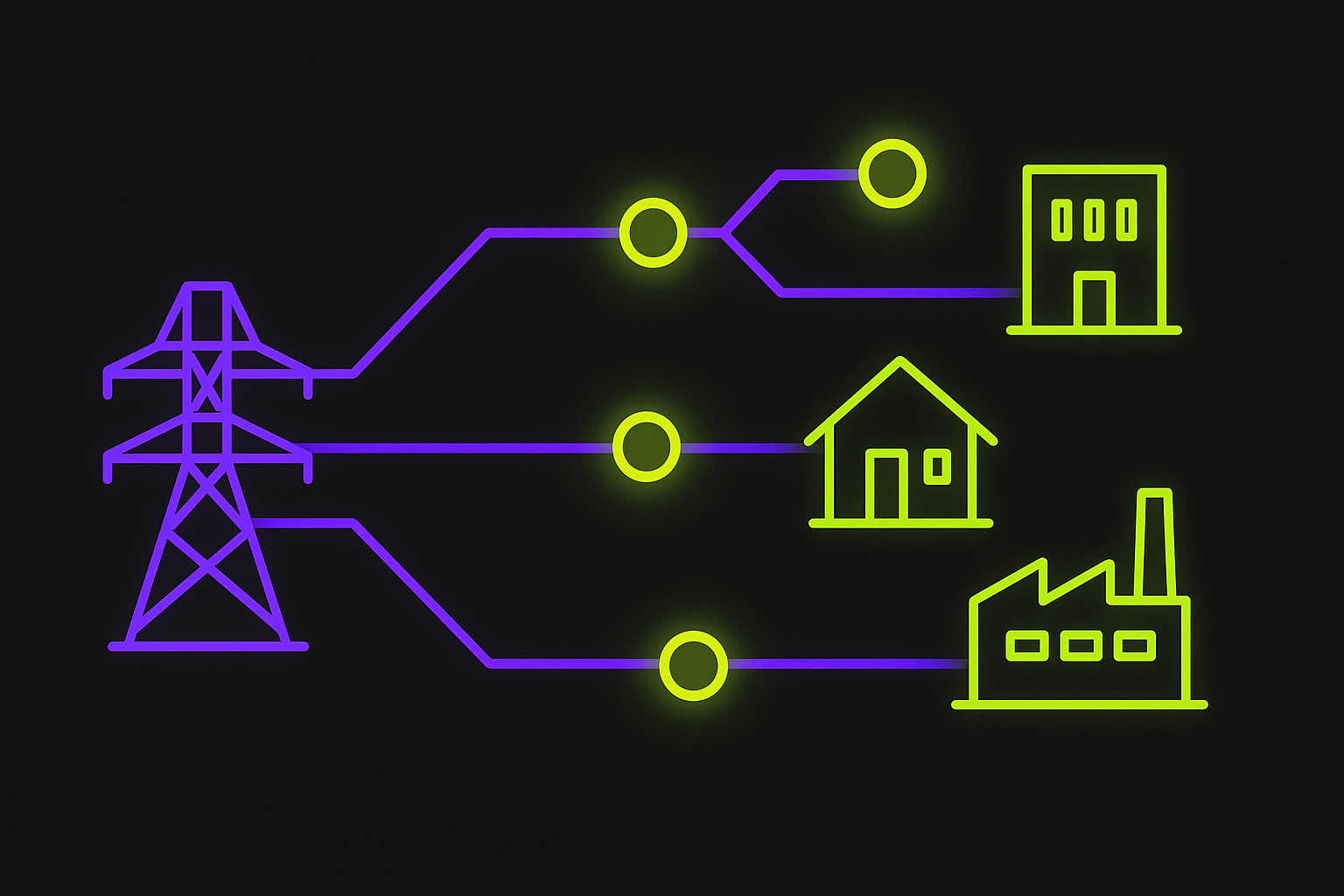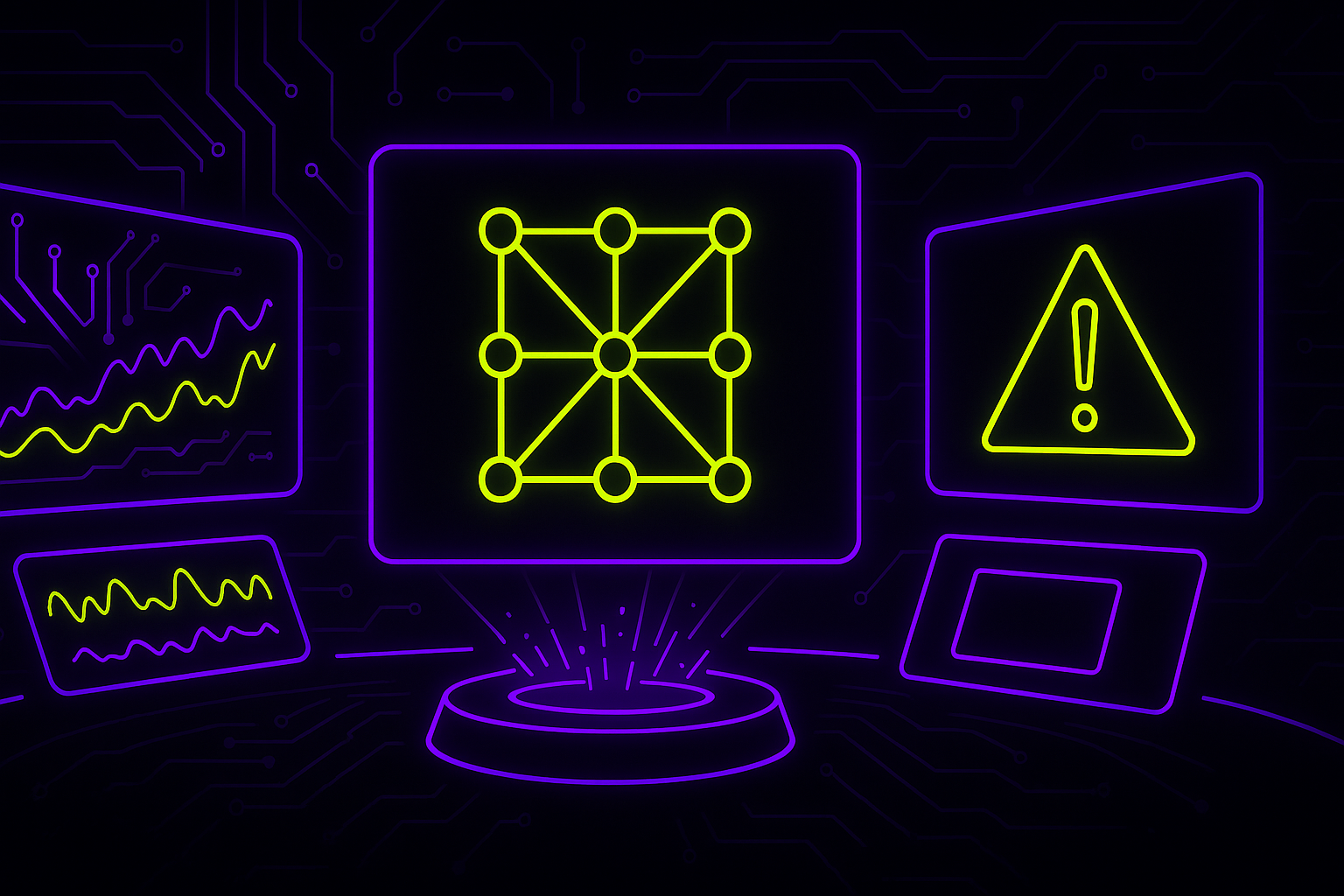The Nervous System of the Modern Grid
Unify fragmented infrastructure. Predict failures 48 hours early. Prevent them autonomously.
From monitoring to intelligence to control — powered by multi-domain sensing + federated AI.
91%
Accuracy
48hrs
Early Warning

$230 Billion Lost Annually to Power Infrastructure Failures
Your monitoring systems aren't helping. Here's why:
Multiple Vendor Systems
Dashboard chaos from multiple vendors creates an incomplete picture of your infrastructure health.
Failures in Milliseconds
Reactive alerts and threshold alarms can't predict cascading failures before they happen.
Operating In Silos
Isolated failures with zero industry learning means you repeat the same mistakes others already made.
The industry needs a fundamental shift from reactive monitoring to predictive intelligence.

One Platform. Four Evolutionary Layers.
We meet you where you are (fragmentation) and take you where you need to be (autonomous control).
VoltryOS
Integration Layer
Unify multiple vendor systems into one dashboard. Connect everything you already own.
Free
- Universal vendor integration
- Single dashboard
- Zero upfront cost
VoltryPredict
Intelligence Layer
Predict failures 48 hours before they happen with federated AI learning from 50M training hours.
$50K/year
- 48-hour early warnings
- Cross-facility learning
- Anomaly detection
VoltryCore
Hardware Layer
Patent-pending sensors that combine electrical, thermal, vibration, and acoustic monitoring in one device.
$200 vs $4,300
- 4 sensing modalities
- 95% cost reduction
- Self-calibrating
Active Control
Autonomous Control
Closed-loop control system that prevents failures autonomously before humans can react.
<10ms response
- Sub-10ms response time
- Zero-click prevention
- Autonomous failover
VoltryOS
Integration Layer
Unify multiple vendor systems into one dashboard. Connect everything you already own.
Free
- Universal vendor integration
- Single dashboard
- Zero upfront cost
VoltryPredict
Intelligence Layer
Predict failures 48 hours before they happen with federated AI learning from 50M training hours.
$50K/year
- 48-hour early warnings
- Cross-facility learning
- Anomaly detection
VoltryCore
Hardware Layer
Patent-pending sensors that combine electrical, thermal, vibration, and acoustic monitoring in one device.
$200 vs $4,300
- 4 sensing modalities
- 95% cost reduction
- Self-calibrating
Active Control
Autonomous Control
Closed-loop control system that prevents failures autonomously before humans can react.
<10ms response
- Sub-10ms response time
- Zero-click prevention
- Autonomous failover
Start free today. Upgrade as you scale.
No credit card required. No vendor lock-in. Own your infrastructure evolution.
Built for Critical Infrastructure
Industry-specific solutions for the facilities that power modern life
Data Centers
Mission-critical uptime at lower TCO
- Real-time PUE reporting
- Cooling optimization
- Predictive maintenance
- Power quality monitoring
$2M+/year savings
Utilities & Substations
Grid resilience through predictive intelligence
- Transformer health monitoring
- NERC CIP compliance
- Arc flash prevention
- Load forecasting
2-5x asset life extension
DER & Microgrids
Orchestrate distributed energy at scale
- IEEE 1547 compliance
- Solar + storage optimization
- Islanding detection
- Faster interconnection permits
40% faster permits
Industrial Facilities
Maximize production, minimize downtime
- Motor vibration analysis
- Power quality monitoring
- Energy cost optimization
- Process reliability
60%+ downtime reduction
Don't see your use case? We support hospitals, manufacturing, cannabis grows, and more.
Proven at Scale
Training Hours
Prediction Accuracy
Patents Filed
Early Warning Average
How We Compare to Traditional Data Center Infrastructure Management
Modern infrastructure demands modern solutions
Vendor Support
Single vendor only
All major vendors
Voltry integrates with Schneider, Eaton, ABB, Siemens, and more - no vendor lock-in
Prediction
Threshold alarms (reactive)
AI-powered forecasting (24-48hr early warning)
Traditional systems only alert after thresholds are crossed. Voltry predicts failures before they happen
Sensing Domains
Electrical only
Electrical + Mechanical + Acoustic
Multi-domain sensing captures the full picture: vibration, temperature, harmonics, ultrasound, and more
Cost per Point
$4,300+
$200
Traditional DCIM costs $4,300+ per monitoring point. Voltry delivers 20x cost reduction
Network Effects
Each facility alone
Federated learning
Voltry learns from all facilities anonymously, improving predictions for everyone without sharing raw data
Ready to modernize your infrastructure monitoring?

Only 847 spots remaining in our Free Tier program
Get $50,000 in Free Monitoring
On Us. Forever.
VoltryOS unified dashboard for your facility. No credit card. No contracts. Just better visibility in 48 hours.
What's Included in Your Free Install
Unified dashboard for all your systems
Real-time monitoring & alerts
Basic predictive analytics
Compliance reporting (NERC CIP, IEEE)
90 days of dedicated support
Free forever - no hidden fees
Setup in 48 hours
or we pay you $1,000
50M training hours
trust VoltryOS
No credit card
required to start
Coming Soon
Open Source Release Q2 2026
Open Source Core.
Enterprise Features.
VoltryOS is built on open source principles. Our core monitoring and data collection layer is MIT licensed, giving you complete transparency and control over your infrastructure data.
We believe vendor lock-in is toxic to critical infrastructure. You should own your data, understand your systems, and have the freedom to modify your monitoring tools.
Our business model is simple: the open source core handles monitoring. Enterprise features like federated AI, predictive analytics, and automated remediation are paid add-ons. No surprises. No bait-and-switch.
voltry/voltryor-core
Public repository
Open source infrastructure monitoring platform. Real-time sensor fusion, edge computing, and unified dashboards for critical infrastructure.
Stars
Forks
Contributors
Recent Activity
feat: Add Modbus TCP support
@jsmith • 2 hours ago
fix: MQTT reconnection logic
@agarcia • 5 hours ago
docs: Update installation guide
@mchen • 1 day ago
MIT License • Updated 2 hours ago
100% Open Core
Join 2,400+ developers building the future of infrastructure monitoring
Ready to Unify Your Infrastructure?
Get started with $50,000 in free monitoring or schedule a personalized demo to see VoltryOS in action.
Questions? Our team is here to help.